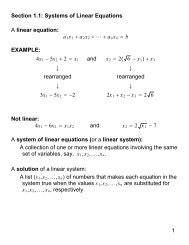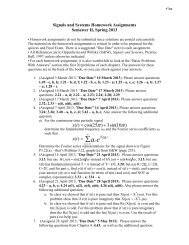Course Notes on Formal Languages and Compilers
Course Notes on Formal Languages and Compilers
Course Notes on Formal Languages and Compilers
Create successful ePaper yourself
Turn your PDF publications into a flip-book with our unique Google optimized e-Paper software.
32<br />
5. REGULAR EXPRESSIONS<br />
These expressi<strong>on</strong>s denote sets <strong>and</strong> are defined as follows:<br />
5<br />
10<br />
(i)<br />
(ii)<br />
(iii)<br />
(iv)<br />
∅ is a regular expressi<strong>on</strong>:<br />
{ε} is a regular expressi<strong>on</strong><br />
{a} is a regular expressi<strong>on</strong> where "a" is a terminal symbol.<br />
If R <strong>and</strong> S are regular expressi<strong>on</strong>s then the following are also regular<br />
expressi<strong>on</strong>s.<br />
(a) R|S<br />
(b) RS<br />
(c) R* (also S*)<br />
- the uni<strong>on</strong><br />
- the c<strong>on</strong>catenati<strong>on</strong><br />
- the transitive closures<br />
15<br />
20<br />
In practice we will write ε <strong>and</strong> not {ε}, "a" <strong>and</strong> not {a}. Of course the set<br />
{a,b,c,d} is then written (a|b|c|d) <strong>and</strong> of course {a,b} ∪ {c,d} would be written<br />
(a|b) | (c|d) as regular expressi<strong>on</strong>s.<br />
Incidentally, ∅* = ε in regular expressi<strong>on</strong>s.<br />
Regular expressi<strong>on</strong>s are useful for defining the structure of reserved words,<br />
identifiers, numbers occuring in programming languages but are not suitable<br />
for defining the structure of blocks, expressi<strong>on</strong>s, statements etc.<br />
Examples of Regular Expressi<strong>on</strong>s:<br />
25<br />
30<br />
35<br />
40<br />
1) Unsigned Integers:<br />
(0|1|2|...|9)(0|1|2...|9)*<br />
2) Integers with an opti<strong>on</strong>al sign<br />
(ε|+|-)(0|1|2|...|9)(0|1|2|...9)*<br />
3) Identifiers:<br />
(a|b|c|...|z)(a|b|c|...|z|0|1|2...|9)*<br />
Exercises: 1) Write a regular expressi<strong>on</strong> defining the structure of a real<br />
number which may include a sign, a decimal point <strong>and</strong> an<br />
exp<strong>on</strong>ent which are opti<strong>on</strong>al.<br />
2) Change the definiti<strong>on</strong> of the first example above so as to<br />
exclude numbers with unneccessary leading zeroes, i.e. to<br />
exclude numbers such as 000, 00156, etc.<br />
Equivalence between regular expressi<strong>on</strong>s <strong>and</strong> regular grammars<br />
45<br />
We shall now show that the sets defined by regular expressi<strong>on</strong>s <strong>and</strong> regular<br />
grammars are equivalent.












